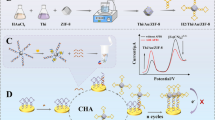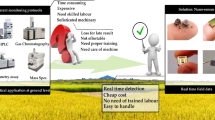Abstract
2,4-Dichlorophenoxyacetic acid (2,4-D) is a typical chlorinated aromatic herbicide which is widely used because of its low cost. Herein, a new fluorescent assay for 2,4-D is developed based on covalent organic frameworks (COFs) and MnO2 nanosheets. The fluorescence of COFs is quenched effectively by MnO2 nanosheets. Ascorbic acid 2-phosphate (AAP) is hydrolyzed by alkaline phosphatase (ALP) to produce ascorbic acid (AA), which reduces MnO2 nanosheets into Mn2+, so the quenched fluorescence recovers. Additionally, 2,4-D can inhibit the catalytic activity of ALP. Therefore, the addition of 2,4-D quenches the fluorescence of COF-MnO2 system again. Under the optimum conditions, this assay displays a wide linear range of 2,4-D from 1 to 150,000 ng/mL with a limit of detection of 0.36 ng/mL. Then, this method is successfully used to measure 2,4-D in rice, millet, and cucumber samples with satisfactory recoveries. Compared with other probes for 2,4-D detection, both of COFs and MnO2 nanosheets are stable, cost-effective, and easily prepared. The sensitivity and linear range of 2,4-D in this strategy are superior to most reported works. This is the first time that a novel sensing platform using fluorescent COFs and MnO2 nanosheets is developed for 2,4-D.








Similar content being viewed by others
References
Bollella P, Fusco G, Tortolini C, Sanzò G, Antiochia R, Favero G, Mazzei F (2016) Inhibition-based first-generation electrochemical biosensors: theoretical aspects and application to 2,4-dichlorophenoxy acetic acid detection. Anal Bioanal Chem 408(12):3203–3211
Boro RC, Kaushal J, Nangia Y et al (2011) Gold nanoparticles catalyzed chemiluminescence immunoassay for detection of herbicide 2,4-dichlorophenoxyacetic acid. Analyst 136(10):2125–2130
Chamkasem N, Morris C (2016) Direct determination of 2,4-dichlorophenoxyacetic acid in soybean and corn by liquid chromatography/tandem mass spectrometry. J Reg Sci 4(2):9–18
Chen H, Zhang ZX, Zhang GM, Guo XF, Zhang HS, Wang H (2010) Liquid chromatographic determination of endogenous phytohormones in vegetable samples based on chemical derivatization with 6-oxy (acetylpiperazine) fluorescein. J Agric Food Chem 58(8):4560–4564
Chen X, Zhang H, Wan Y, Chen X, Li Y (2018) Determination of 2,4-dichlorophenoxyacetic acid (2,4-D) in rat serum for pharmacokinetic studies with a simple HPLC method. PLoS One 13(1):e0191149
Cote AP, Benin AI, Ockwig NW et al (2005) Porous, crystalline, covalent organic frameworks. Science 310(5751):1166–1170
Ding JH, Lu Z, Wang RZ, Shen G, Xiao L (2014) Piezoelectric immunosensor with gold nanoparticles enhanced competitive immunoreaction technique for 2,4-dichlorophenoxyacetic acid quantification. Sensors Actuators B Chem 193:568–573
Ding SY, Dong M, Wang YW, Chen YT, Wang HZ, Su CY, Wang W (2016) Thioether-based fluorescent covalent organic framework for selective detection and facile removal of mercury (II). J Am Chem Soc 138(9):3031–3037
Galvão AC, Robazza WS, Bianchi AD, Matiello JA, Paludo AR, Thomas R (2018) Solubility and thermodynamics of vitamin C in binary liquid mixtures involving water, methanol, ethanol and isopropanol at different temperatures. J Chem Thermodyn 121:8–16
Habila MA, Alothman ZA, Al-tamrah SA et al (2015) Activated carbon from waste as an efficient adsorbent for malathion for detection and removal purposes. J Ind Eng Chem 32:336–344
Haeri SA, Abbasi S (2016) Biocoacervation extraction combined with dispersive solid phase extraction using a reversed-phase core–shell magnetic molecularly imprinted sorbent for 2,4-dichlorophenoxyacetic acid prior to its determination by HPLC. J Iran Chem Soc 13(11):1993–1999
Hu XL, Wu XM, Fang X et al (2016) Switchable fluorescence of gold nanoclusters for probing the activity of alkaline phosphatase and its application in immunoassay. Biosens Bioelectron 77:666–672
Huang M, Zhang YX, Li F et al (2014) Self-assembly of mesoporous nanotubes assembled from interwoven ultrathin birnessite-type MnO2 nanosheets for asymmetric supercapacitors. Sci Rep 4:3878
Kandambeth S, Biswal BP, Chaudhari HD et al (2017) Selective molecular sieving in self-standing porous covalent-organic-framework membranes. Adv Mater 29(2):1603945
Kim SJ, Gobi KV, Tanaka H et al (2008) A simple and versatile self-assembled monolayer based surface plasmon resonance immunosensor for highly sensitive detection of 2,4-D from natural water resources. Sensors Actuators B Chem 130(1):281–289
Lescano MR, Pizzul L, Castillo MP, Zalazar CS (2018) Glyphosate and aminomethylphosphonic acid degradation in biomixtures based on alfalfa straw, wheat stubble and river waste. J Environ Manag 228:451–457
Li ZP, Zhang YW, Xia H, Mu Y, Liu X (2016) A robust and luminescent covalent organic framework as a highly sensitive and selective sensor for the detection of Cu2+ ions. Chem Commun 52(39):6613–6616
Lin YH, Lu F, Wang J (2004) Disposable carbon nanotube modified screen-printed biosensor for amperometric detection of organophosphorus pesticides and nerve agents. Electroanalysis 16(1-2):145–149
Liu J, Yang SH, Li FY, Dong L, Liu J, Wang X, Pu Q (2015) Highly fluorescent polymeric nanoparticles based on melamine for facile detection of TNT in soil. J Mater Chem A 3(18):10069–10076
Liu ZG, Cai XH, Lin XF, Zheng Y, Wu Y, Chen P, Weng S, Lin L, Lin X (2016a) Signal-on fluorescent sensor based on GQDs–MnO2 composite for glutathione. Anal Methods 8(11):2366–2374
Liu L, Xia L, Guo C, Wu C, Chen G, Li G, Sun Z, You J (2016b) A sensitive and efficient method for the determination of 8 chlorophenoxy acid herbicides in crops by dispersive liquid–liquid microextraction and HPLC with fluorescence detection and identification by MS. Anal Methods 8(17):3536–3544
Liu J, Nan Y, Chang X, Li X, Fang Y, Liu Y, Tang Y, Wang X, Li R, Ma J (2017) Hierarchical nitrogen-enriched porous carbon materials derived from Schiff-base networks supported FeCo2O4 nanoparticles for efficient water oxidation. Int J Hydrog Energy 42(16):10802–10812
Lv B, Wei M, Liu Y, Liu X, Wei W, Liu S (2016) Ultrasensitive photometric and visual determination of organophosphorus pesticides based on the inhibition of enzyme-triggered formation of core-shell gold-silver nanoparticles. Microchim Acta 183(11):2941–2948
Maleki N, Safavi A, Hasanpour F et al (2008) Determination of traces of 2,4-dichlorophenoxy acetic acid in environmental samples. Sci Iran:430–434
Pang S, Yang TX, He LL (2016) Review of surface enhanced Raman spectroscopic (SERS) detection of synthetic chemical pesticides. TrAC Trends Anal Chem 85:73–82
Park JY, Choi JH, Abd El-Aty AM et al (2011) Development and validation of an analytical method for determination of endocrine disruptor, 2,4-D, in paddy field water. Biomed Chromatogr 25(9):1018–1024
Peng YW, Huang Y, Zhu YH, Chen B, Wang L, Lai Z, Zhang Z, Zhao M, Tan C, Yang N, Shao F, Han Y, Zhang H (2017) Ultrathin two-dimensional covalent organic framework nanosheets: preparation and application in highly sensitive and selective DNA detection. J Am Chem Soc 139(25):8698–8704
Qu FL, Pei HM, Kong RM, Zhu S, Xia L (2017) Novel turn-on fluorescent detection of alkaline phosphatase based on green synthesized carbon dots and MnO2 nanosheets. Talanta 165:136–142
Qu F, Meng LX, Zi YQ, You J (2019) Ratiometric detection of alkaline phosphatase based on aggregation-induced emission enhancement. Anal Bioanal Chem 411(28):7431–7440
Qu F, Wang H, You JM (2020) Dual lanthanide-probe based on coordination polymer networks for ratiometric detection of glyphosate in food samples. Food Chem 323:126815
Reddy KS, Gambrell RP (1987) Factors affecting the adsorption of 2,4-D and methyl parathion in soils and sediments. Agric., Ecosyst. Environ 18(3):231–241
Roshan S, Asgharinezhad AA et al (2011) Determination of 2,4-D in environmental samples by three phases directly suspended LPME combined with HPLC-UV. Anal Methods 3(10):2261–2267
Stegbauer L, Schwinghammer K, Lotsch BV (2014) A hydrazone-based covalent organic framework for photocatalytic hydrogen production. Chem Sci 5(7):2789–2793
Sun ZJ, Shu D, Lv CJ, Zhang Q, He C, Tian S (2013) Fabrication and supercapacitive behavior of tetramethylammonium ion-intercalated MnO2 prepared by an exfoliation and self-assembly process. J Alloys Compd 569:136–143
Vinayaka AC, Basheer S, Thakur MS (2009) Bioconjugation of CdTe quantum dot for the detection of 2, 4-dichlorophenoxyacetic acid by competitive fluoroimmunoassay based biosensor. Biosens. Bioelectron 24(6):1615–1620
Wang XY, Yu JL, Wu XQ, Fu J, Kang Q, Shen D, Li J, Chen L (2016) A molecular imprinting-based turn-on ratiometric fluorescence sensor for highly selective and sensitive detection of 2,4-dichlorophenoxyacetic acid (2,4-D). Biosens Bioelectron 81:438–444
Wang QL, Li J, Li XD, Ding LS, Xie J, Qing LS (2017) A simple nano-SiO2-based ELISA method for residue detection of 2,4-dichlorophenoxyacetic acid in bean sprouts. Food Anal Methods 10(5):1500–1506
Wu MX, Yang YW (2017) Applications of covalent organic frameworks (COFs): from gas storage and separation to drug delivery. Chin Chem Lett 28(6):1135–1143
Xiao T, Sun J, Zhao JH, Wang S, Liu G, Yang X (2018) FRET effect between fluorescent polydopamine nanoparticles and MnO2 nanosheets and its application for sensitive sensing of alkaline phosphatase. ACS Appl Mater Interfaces 10(7):6560–6569
Yan X, Li HX, Han XS, Su X (2015) A ratiometric fluorescent quantum dots based biosensor for organophosphorus pesticides detection by inner-filter effect. Biosens Bioelectron 74:277–283
Yang YJ, Yuan WT, Li SB, Yang X, Xu J, Jiang Y (2015) Manganese dioxide nanoparticle enrichment in porous conducting polymer as high performance supercapacitor electrode materials. Electrochim Acta 165:323–329
Zhang CL, Zhang SM, Yan YH, Xia F, Huang A, Xian Y (2017) Highly fluorescent polyimide covalent organic nanosheets as sensing probes for the detection of 2,4,6-trinitrophenol. ACS Appl Mater Interfaces 9(15):13415–13421
Zhang XJ, He MQ, He P, Li C, Liu H, Zhang X, Ma Y (2018) Ultrafine nano-network structured bacterial cellulose as reductant and bridging ligands to fabricate ultrathin K-birnessite type MnO2 nanosheets for supercapacitors. Appl Surf Sci 433:419–427
Zhao X, Yan N (2015) One-pot synthesis and assembly of melamine-based nanoparticles for microporous polymer organic frameworks and their application as a support for a silver nanoparticle catalyst. RSC Adv 5(86):69955–69961
Zhao ZL, Fan HH, Zhou GF, Bai H, Liang H, Wang R, Zhang X, Tan W (2014) Activatable fluorescence/MRI bimodal platform for tumor cell imaging via MnO2 nanosheet–aptamer nanoprobe. J Am Chem Soc 136(32):11220–11223
Funding
This work was supported by Natural Science Foundation of Shandong Province, China (ZR2019QB010), and the Scientific Research Foundation of Qufu Normal University (BSQD20130117).
Author information
Authors and Affiliations
Contributions
Fei Qu and Yang Sun contributed equally to this work.
Corresponding author
Ethics declarations
Ethical Approval
This study does not contain experiments that involve human or animals other than the authors who performed the work.
Conflict of Interest
Fei Qu declares that she has no conflict of interest. Yang Sun declares that she has no conflict of interest. Shuxian Guo declares that she has no conflict of interest. Hang Yan declares that she has no conflict of interest. Jinmao You declares that he has no conflict of interest.
Additional information
Publisher’s Note
Springer Nature remains neutral with regard to jurisdictional claims in published maps and institutional affiliations.
Electronic supplementary material
ESM 1
(DOCX 658 kb)
Rights and permissions
About this article
Cite this article
Qu, F., Sun, Y., Guo, S. et al. Fluorescent Detection of 2,4-Dichlorophenoxyacetic Acid in Food Samples Based on Covalent Organic Frameworks and MnO2 Nanosheets. Food Anal. Methods 13, 1842–1851 (2020). https://doi.org/10.1007/s12161-020-01807-2
Received:
Accepted:
Published:
Issue Date:
DOI: https://doi.org/10.1007/s12161-020-01807-2




